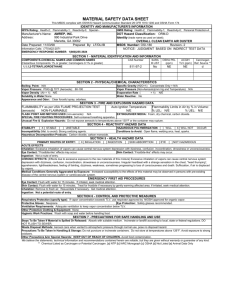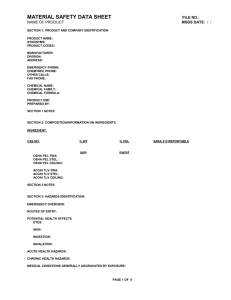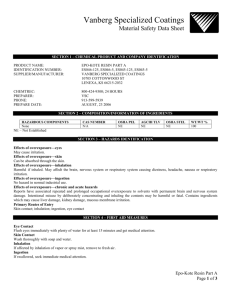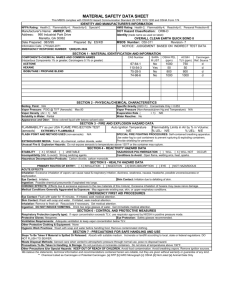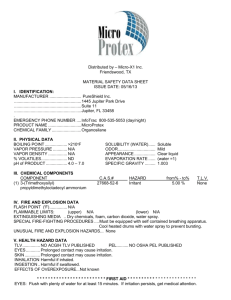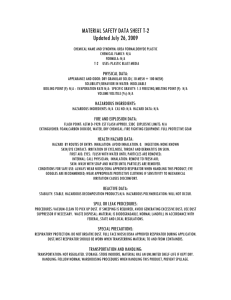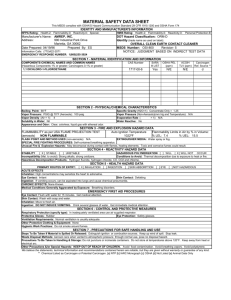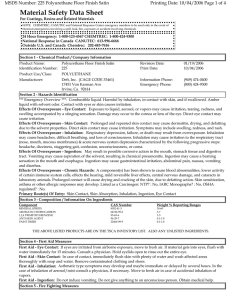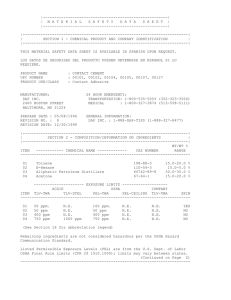Material Safety
advertisement
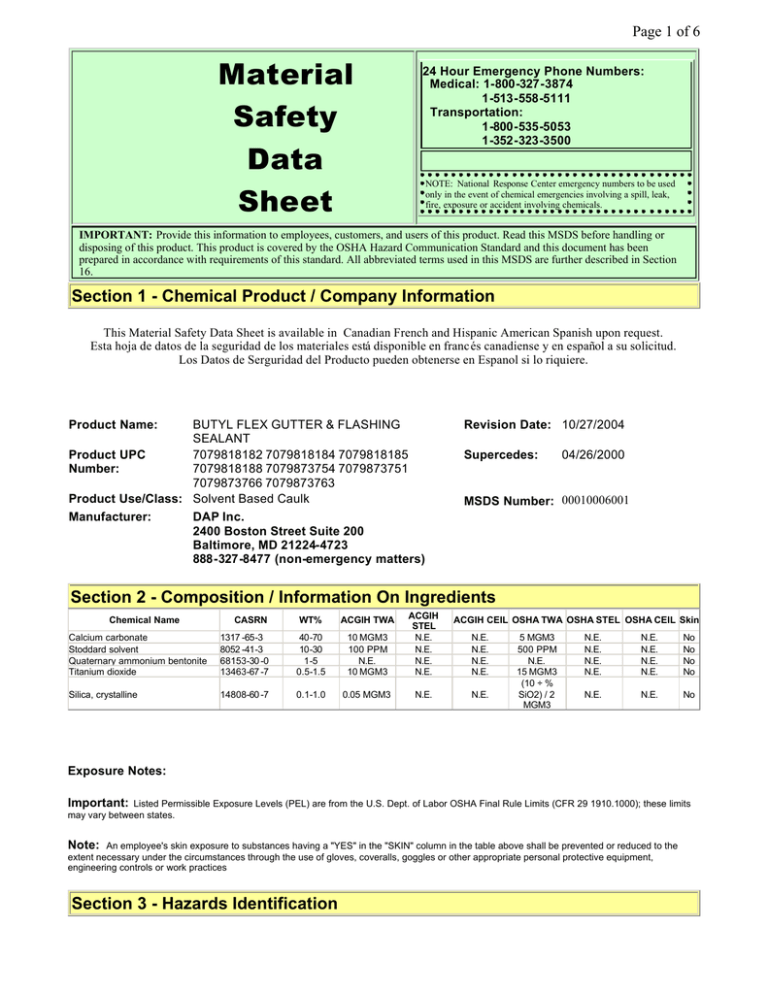
Page 1 of 6 Material Safety Data Sheet 24 Hour Emergency Phone Numbers: Medical: 1-800-327-3874 1-513-558-5111 Transportation: 1-800-535-5053 1-352-323-3500 NOTE: National Response Center emergency numbers to be used only in the event of chemical emergencies involving a spill, leak, fire, exposure or accident involving chemicals. IMPORTANT: Provide this information to employees, customers, and users of this product. Read this MSDS before handling or disposing of this product. This product is covered by the OSHA Hazard Communication Standard and this document has been prepared in accordance with requirements of this standard. All abbreviated terms used in this MSDS are further described in Section 16. Section 1 - Chemical Product / Company Information This Material Safety Data Sheet is available in Canadian French and Hispanic American Spanish upon request. Esta hoja de datos de la seguridad de los materiales está disponible en francés canadiense y en español a su solicitud. Los Datos de Serguridad del Producto pueden obtenerse en Espanol si lo riquiere. Product Name: BUTYL FLEX GUTTER & FLASHING SEALANT Product UPC 7079818182 7079818184 7079818185 Number: 7079818188 7079873754 7079873751 7079873766 7079873763 Product Use/Class: Solvent Based Caulk Manufacturer: DAP Inc. 2400 Boston Street Suite 200 Baltimore, MD 21224-4723 888-327-8477 (non-emergency matters) Revision Date: 10/27/2004 Supercedes: 04/26/2000 MSDS Number: 00010006001 Section 2 - Composition / Information On Ingredients Calcium carbonate Stoddard solvent Quaternary ammonium bentonite Titanium dioxide 1317 -65-3 8052 -41-3 68153-30 -0 13463-67 -7 40-70 10-30 1-5 0.5-1.5 10 MGM3 100 PPM N.E. 10 MGM3 ACGIH STEL N.E. N.E. N.E. N.E. Silica, crystalline 14808-60 -7 0.1-1.0 0.05 MGM3 N.E. Chemical Name CASRN WT% ACGIH TWA ACGIH CEIL OSHA TWA OSHA STEL OSHA CEIL Skin N.E. N.E. N.E. N.E. N.E. 5 MGM3 500 PPM N.E. 15 MGM3 (10 ÷ % SiO2) / 2 MGM3 N.E. N.E. N.E. N.E. N.E. N.E. N.E. N.E. No No No No N.E. N.E. No Exposure Notes: Important: Listed Permissible Exposure Levels (PEL) are from the U.S. Dept. of Labor OSHA Final Rule Limits (CFR 29 1910.1000); these limits may vary between states. Note: An employee's skin exposure to substances having a "YES" in the "SKIN" column in the table above shall be prevented or reduced to the extent necessary under the circumstances through the use of gloves, coveralls, goggles or other appropriate personal protective equipment, engineering controls or work practices Section 3 - Hazards Identification Page 2 of 6 Emergency Overview: A white to off-white paste with a strong solvent odor. WARNING! Do not breathe vapors. Avoid skin and eye contact. Combustible liquid and vapor. Vapors may ignite explosively. Keep away from heat, sparks and flame. Harmful or fatal if swallowed. May cause eye, skin, nose, throat and respiratory tract irritation. Refer to other MSDS sections for other detailed information. Effects Of Overexposure - Eye Contact: May cause eye irritation. Signs and symptoms may include: pain, tears, swelling, redness and blurred vision. Effects Of Overexposure - Skin Contact: May cause skin irritation. Effects Of Overexposure - Inhalation: Vapor harmful. May affect the brain or nervous system causing dizziness, headache or nausea. Inhalation may cause irritation to the respiratory tract (nose, mouth, mucous membranes). Inhalation of high vapor concentrations can cause central nervous system depression and narcosis. Effects Of Overexposure - Ingestion: Harmful or fatal if swallowed. If ingested, may cause vomiting, diarrhea, and depressed respiration. Effects Of Overexposure - Chronic Hazards: NOTICE: Reports have associated repeated and prolonged occupational overexposure to solvents with permanent brain and nervous system damage. Intentional misuse by deliberately concentrating and inhaling the contents may be harmful or fatal. Prolonged or repeated contact with skin can cause defatting of the skin, which may lead to dermatitis. Primary Route(s) Of Entry: Skin Contact, Skin Absorption, Inhalation Medical Conditions which May be Aggravated by Exposure: Pre-existing eye, skin and pulmonary disorders may be aggrevated by exposure to this product. Section 4 - First Aid Measures First Aid - Eye Contact: If material gets into eyes, flush with water immediately for 15 minutes. Consult a physician. First Aid - Skin Contact: Wash off with soap and water. First Aid - Inhalation: If inhaled, remove to fresh air. If not breathing, give artificial respiration. If breathing is difficult, give oxygen. Get medical attention immediately. First Aid - Ingestion: Harmful or fatal if liquid is aspirated into the lungs. If swallowed, drink 8-10 oz. of water, get immediate medical attention. Do not induce vomiting. Note to Physician: No Information. COMMENTS: Call Medical Emergency at 1-800-327-3874 if any irritation or complication arise from any of the above routes of entry. Section 5 - Fire Fighting Measures Flash Point, F: 105 Method: ( Seta Closed Cup) Lower Explosive Limit, %: Not Established Upper Explosive Limit, %: Not Established Extinguishing Media: Carbon Dioxide, Dry Chemical, Foam Unusual Fire And Explosion Hazards: Do not smoke. Extinguish all flames and pilot lights, and turn off stoves, heaters, electric motors and other sources of ignition during use and until all vapors are gone. Store away from caustics and oxidizers. Containers may explode if exposed to extreme heat. Page 3 of 6 Special Firefighting Procedures: Wear self-contained breathing apparatus pressure-demand (NIOSH approved or equivalent) and full protective gear. Use water spray to cool exposed surfaces. Section 6 - Accidental Release Measures Steps To Be Taken If Material Is Released Or Spilled: Wear proper protective equipment as specified in Section 8. Immediately eliminate sources of ignition. Scrape up dried material and place into containers. Section 7 - Handling And Storage Handling: KEEP OUT OF REACH OF CHILDREN! DO NOT TAKE INTERNALLY. Do not breathe vapors. Provide fresh air such that chemical odors cannot be detected during use and while drying. Avoid contact with skin and eyes. Use in well ventilated area. Keep containers closed when not in use. Intentional misuse by deliberately concentrating and inhaling vapors may be harmful or fatal. Keep away from heat. Vapors are heavier than air and will collect in low areas. Check all low areas (basements, sumps, etc.) for vapor before entering. Wash thoroughly after handling. Do not smoke. Storage: Avoid excessive heat and freezing. Keep away from heat and sources of ignition. Store away from caustics and oxidizers. Do not store at temperatures above 120 degrees F. Section 8 - Exposure Controls / Personal Protection Precautionary Measures: Please refer to other sections and subsections of this MSDS. Engineering Controls: Provide sufficient general and/or local exhaust ventilation to maintain exposure below recommended exposure limit. Ensure fresh air entry during application and drying. If you experience eye watering, headache or dizziness or if air monitoring demonstrates vapor/mist levels are above applicable limits, wear an appropriate, properly fitted respirator (NIOSH approved) during and after application. Follow respirator manufacturer's directions for respirator use. Vapors are heavier than air and may spread along floors. Respiratory Protection: A NIOSH -approved air purifying respirator with an organic vapor cartridge or canister may be necessary under certain circumstances where airborne concentrations are expected to exceed exposure limits. A respiratory protection program that meets the OSHA 1910.134 and ANSI Z88.2 requirements must be followed whenever workplace conditions warrant a respirator's use. If you experience eye watering, headache or dizziness or if air monitoring demonstrates vapor/mist levels are above applicable limits, wear and appropriate, properly fitted respirator (NIOSH approved) during and after application. Skin Protection: Impervious gloves. Eye Protection: Goggles or safety glasses with side shields. Other protective equipment: Provide eyewash and solvent impervious apron if body contact may occur. Hygienic Practices: Remove and wash contaminated clothing before re-use. Do not smoke. Section 9 - Physical And Chemical Properties Boiling Range: Odor: Appearance: Solubility in H2O: Freeze Point: Vapor Pressure: Physical State: 350 - 355 F Strong Solvent White to Off-White Not Established Not Established 5 mmHg Paste Vapor Density: Odor Threshold: Evaporation Rate: Specific Gravity: pH: Viscosity: Not Established Not Established Faster Than n-Butyl Acetate 1.441 Not Applicable Not Established When reported, vapor pressure of this product has been calculated theoretically based on its constituent makeup and has not been determined Page 4 of 6 experimentally. (See section 16 for abbreviation legend) Section 10 - Stability And Reactivity Conditions To Avoid: Excessive heat and freezing. Incompatibility: Strong acids and strong bases. Hazardous Decomposition Products: Normal decomposition products, i.e., COx, NOx. Hazardous Polymerization: Hazardous polymerization will not occur under normal conditions. Stability: Stable under normal conditions. Section 11 - Toxicological Information Product LD50: Not Established Product LC50: Not Established Carcinogenicity: CAS No. Chemical Name ACGIH OSHA IARC NTP WT% ----- 0.5-1.5 Known carcinogen. 0.1-1.0 13463-67 -7 Titanium dioxide ----- ----- Classification not possible from current data. 14808-60 -7 Silica, crystalline Suspected human carcinogen. ----- ----- Significant Data with Possible Relevance to Humans: None Section 12 - Ecological Information Ecological Information: None known. Section 13 - Disposal Information Disposal Information: State and Local regulations/restrictions are complex and may differ from Federal regulations. Responsibility for proper waste disposal is with the owner of the waste. EPA Waste Code if Discarded (40 CFR Section 261): None; yields no liquid component when evaluated by EPA method 1311 (TCLP) Section 14 - Transportation Information DOT Proper Shipping Name: DOT Technical Name: DOT Hazard Class: Combustible liquid, n.o.s. (in Packing Group: accordance with 49CFR173.150 (f)(2) when transported domestically by ground) Combustible liquid Hazard Subclass: None (3 for non-domestic / or DOT UN/NA Number: air) None (III if not domestic by ground) N.A. None (NA1993 when not domestic ground) Note: The shipping information provided is applicable for domestic ground transport only. Different categorization may apply if shipped via other modes of transportation and/or to non-domestic destinations. Page 5 of 6 Section 15 - Regulatory Information CERCLA - SARA Hazard Category: This product has been reviewed according to the EPA 'Hazard Categories' promulgated under Sections 311 and 312 of the Superfund Amendment and Reauthorization Act of 1986 (SARA Title III) and is considered, under applicable definitions, to meet the following categories: Immediate Health Hazard, Chronic Health Hazard SARA Section 313: This product contains the following substances subject to the reporting requirements of Section 313 of Title III of the Superfund Amendment and Reauthorization Act of 1986 and 40 CFR part 372: None Toxic Substances Control Act: All ingredients in this product are either on TSCA inventory list, or otherwise exempt. This product contains the following chemical substances subject to the reporting requirements of TSCA 12(B) if exported from the United States: None U.S. State Regulations: New Jersey Right-to-Know: The following materials are non-hazardous, but are among the top five components in this product: Chemical Name CAS Number Butene, homopolymer Propene polymers Isobutylene/isoprene copolymer Proprietary Proprietary Proprietary WT% 7-13 5-10 1-5 Pennsylvania Right-to-Know: The following non-hazardous ingredients are present in the product at greater than 3%: Chemical Name CAS Number Butene, homopolymer Propene polymers Isobutylene/isoprene copolymer Proprietary Proprietary Proprietary WT% 7-13 5-10 1-5 California Proposition 65: Warning: The following ingredients present in the product are known to the State of California to cause cancer: Chemical Name Silica, crystalline CAS Number 14808-60-7 Definition Date Listed WT% Carcinogenic. Listed: October 1, 1988 0.1-1.0 Warning: The following ingredients present in the product are known to the State of California to cause birth defects or other reproductive harm: Page 6 of 6 None. Section 16 - Other Information HMIS Ratings: Health: 2 Flammability: 2 Reactivity: 0 VOLATILE ORGANIC COMPOUNDS, GR/LTR: 221.1 LB/GAL: 1.8 Personal Protection: X WT%: 15.377 REASON FOR REVISION: Periodic Update Legend: N.A. – Not Applicable ACGIH – American Conference of Governmental Industrial Hygienists N.E. – Not Established SARA – Superfund Amendments and Reauthorization Act of 1986 N.D. – Not Determined NJRTK – New Jersey Right-to-Know Law VOC – Volatile Organic Compound OSHA – Occupational Safety and Health Administration PEL – Permissible Exposure Limit HMIS – Hazardous Materials Identification System TLV – Threshold Limit Value NTP – National Toxicology Program STEL – Short Term Exposure Limit CEIL – Ceiling Exposure Limit LD50 – Lethal Dose 50 LC50 – Lethal Concentration 50 F – Degree Fahrenheit C – Degree Celcius MSDS – Material Safety Data Sheet CASRN – The Chemical Abstracts Service Registry Number DAP believes the data and statements contained herein are accurate as of the date hereof. They are offered in good faith as typical values and not as a product specification. NO WARRANTY OF MERCHANTABILITY, WARRANTY OF FITNESS FOR ANY PARTICULAR PURPOSE OR ANY OTHER WARRANTY, EXPRESS OR IMPLIED, IS MADE WITH REGARD TO THE INFORMATION HEREIN PROVIDED OR THE PRODUCT TO WHICH THE INFORMATION REFERS. Since this document is intended only as a guide to the appropriate use and precautionary handling of the referenced product by a properly trained person, it is therefore the responsibility of the user to (i) review the recommendations with due consideration for the specific context of the intended use and (ii) determine if they are appropriate. <End of MSDS>
